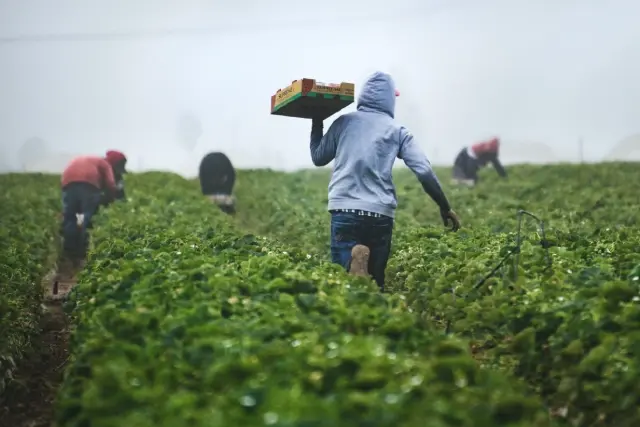Nearly everything is digital these days—even in restaurants. It’s one of the things that separates the restaurants that are winning from the ones that aren’t. That’s why Dan Gertsacov, former CCO and global CMO of Focus Brands and now senior advisor with McKinsey & Company—who has an extensive background in both tech and restaurants, is helping franchisees develop their businesses in the technological space.
“My path into the industry when I was young—literally twelve years old—I wanted to be a professional chef,” Dan says. “Once I attended culinary school, I realized how difficult of a profession it was. It was going to be a lifelong hobby, but not my profession.”
Instead, he veered into media and technology via a career with Google. He helped the then-young internet company establish itself in Latin America and the Caribbean. Then a mentor, one of the largest QSR franchisees in the world, invited Dan back into the restaurant business as a chief marketing and digital officer. Some things stayed the same, however: he still spent his days helping organizations and teams grow through adversity. That held true when he became the CCO and global CMO of Focus Brands, and still now with McKinsey & Company.
“My experience is anchored in digital,” Dan says. “How do you make money from it as a franchisee? How do you think about it strategically as a franchisor? Then how do you help organizations move through that?”
Now, Dan’s hobby and his passion are part of his work. Although he’s not behind the grill, he cooks up ways for others to thrive in what he calls “this crazy, amazing industry.” We interviewed Dan about how QSRs can adapt to the challenges of the digital age and emerge as flexible, competitive players in the restaurant space.
Your opportunities are new; your challenges are timeless
Yes, the environment for restaurants has been challenging since the onset of COVID-19. But the restaurant space has always been challenging, Dan says—and the opportunities now are as big as they’ve ever been.
“Some things have remained constant,” Dan says. “Everyone needs to eat. That is not changing. Everybody wants convenience. Everybody wants value for money.”
The difference now is that restaurants must remain connected and relevant in a world that has gone digital. But it’s only the medium that has changed. These digital challenges facing QSRs right now are addressing the very same basic customer needs. Remember, Dan says, that the drive-thru was once an innovation for convenience—all we’re doing is creating new definitions for what customers want.
“You don't need to be able to write software code to recognize that the world that we live in is connected to our phones,” Dan says. “We need to make food, serve food and run a business in a digital world.”
Sure, it would be most convenient for a restaurant to maintain its existing model, but customers now want and expect to access anything from anywhere. How people find out about your food, how they order it, how they get it delivered—each has changed, and continues to change. The challenge—and the opportunity—for a QSR is to continue serving the constant need for great, hot food at a good price with a welcome experience, while adapting to the customer expectation for digital engagement.
“The people who do that well are going to profit enormously,” Dan says, “and the people who struggle, who want to stay with the way it’s always been done, they’re going to find themselves on the outside looking in.”
Establish foundations for digital growth
Whenever Dan is talking with franchisees who are self-identified non-digital people, he simply points to both of their phones. “We are both here physically and virtually,” he says. “Every one of our customers’ experience is going to be both, too.”
In order to make that experience a positive one for both the customer and the business, Dan establishes three foundations with franchisees adapting to the digital world:
First foundation: Lean in and get curious. All this talk about evolving for a digital world is enough to freak out anyone without a software engineering pedigree—but Dan reminds us that the techy stuff doesn’t need to be so technical. “The nature of the technology we’re talking about, and understanding the trends, is learnable,” he says. “Digital is a tool. We do not need to be afraid of the tool. We need to have curiosity.”
With that interest and willingness to learn, franchisees are capable of understanding a) the basics of what needs to be done, b) the business drivers to turn profit and c) who the players are—the platforms, the tools and the tech.
“If I can understand the context I need to operate in, that’s a lot of the heavy lifting,” Dan says.
Second foundation: Identify everyone’s roles. “Step two is making sure I understand my role and the role of the brand, the role of partners, the role of agencies,” Dan says.
Most franchisees pay the franchisor for developing the brand, the color scheme, the logo design, the menu. A lot of digital initiatives may fold into this role. Franchisees, on the other hand, bring those things to life in the service. They do local store marketing and connect with the community. In the digital space, they might maintain a Facebook presence, post to Instagram, and create TikToks connected to but separate from the broader advertising strategy.
This foundation extends to the team members you hire and the organizations you partner with. “I’ve got to hire a team that can lean in and adapt,” Dan says. “I’ve got to work with partners who are agile. I’ve got to work with brands who are adapting one step ahead. Do these people understand digital? Do they understand social media? Are they part of the trends?”
Third foundation: Stay involved. Dan recognizes the possibility of outsourcing all of those digital responsibilities and more. “I have a ton of respect for all the third-party aggregators,” he says. “They’re really good at what they do. They’re great technology partners, great marketers. But the brand is responsible for the experience.”
He draws a comparison with the airline industry. If a carrier pointed all customers to Expedia to book flights, pretty soon, Expedia has the leverage on that relationship. He sees the same thing happening in the restaurant industry.
“We need to live in a world where consumers can choose to order from the brand or in a third-party marketplace,” Dan proposes. “We need to be in both spaces so that we don’t lose the connection with our own consumers.”
Invest your attention in the digital space
We asked Dan what areas franchisees in the QSR space should keep an eye on investing in, and he gave us cutting-edge answers that, at their core, are actually old-school ones.
- Respecting customer data. Holding information about your customers has entered a whole new realm, thanks to apps and digital loyalty programs. But customers have always offered up their information—which means, they have always trusted you to treat it responsibly, and to give them value for it.
“We used to do this in a bowl with business cards: Put your card in, we’ll do a raffle, you’ll win lunch,” Dan says. “They were sharing their data with you by leaving their business card. Think about that the same way now: What’s the exchange? You have to respect that relationship.”
Dan also reminds us that restaurants don’t truly “own” their customers’ email addresses and so on. The customer owns their info, and they should be able to opt out anytime. This adds extra incentive for you, the restaurant owner or franchisee, to offer them meaningful value in exchange for that access.
- Optimizing supply chain management. Again, supply chain management is nothing new in itself. Knowing what you have, how long you’ve had it, what you’re getting, and where you’re getting it: these are essential for any restaurant.
But understanding that supply chain on a level that allows you to optimize it? “That is, I think, the next frontier in restaurant management,” Dan says. With improvements and developments in logistics, this space is ripe for advancement—and savvy franchisees will keep their mind open to this space.
- Relationships with staff. Okay, there’s not much revolutionary about the idea that healthy interpersonal relationships between team members—and particularly between managers and hourly staff—will boost retention and improve operations. But with his history in the tech space, Dan looks at actual, measurable ways that these benefits affect the bottom line.
“The environment that you create to work in will differentiate the kind of consumer experience you have,” he says.
His concrete example looks at QSRs in malls. The top factor that determines consumer demand in the food court is not the promotion or the menu; it’s how long the line is. And how long the line is depends on how well staffed the location is.
“McDonald's can handle an incredible amount of throughput if they've got enough people in the kitchen, enough people serving customers,” Dan says. “But if they don't, if they misunderstood the demand, or don't have enough staff, a person goes somewhere else. They’re not serving that convenience—and it was a staffing decision.”
Now the decision might be directly how many people a manager scheduled. But it could also be a result of the benefits package, or the nature of the work environment.
“The number one thing is a relationship between the manager and the staff,” Dan says. “And these are decisions you get to choose. These feel like soft skills, but they lead directly to customer experience, which leads to traffic, average check, profit, all those things that everybody wants.”
The key advice for growing your digital business
Dan offers this in six words: Think big, start small, act fast.
“The secret to McDonald's turnaround in so many countries was that we followed this very simple playbook,” he says. And best of all, it’s a growth mindset that any franchisee can adapt.
Think big.
For any brand, Dan sees stores (and people) that sell more, and ones that sell less. “The people who sell more, in my experience, are the ones that think bigger,” he says. Franchisees don’t need to think big on a brand level—big marketing campaigns and the like come from corporate. But living the values of the brand? That’s the big picture for a franchisee.
“Really, it’s thinking about what’s going in my customers’ lives,” Dan says. “Am I pushing my brand to be more relevant with the food we offer, the advertising we do, the experience we’re creating?”
So think big in the context of what it’s like to be your customers and what matters to them. Then, add that value. “I wouldn’t want to get three emails from me this week—let’s send one email,” Dan offers as an example. “And let’s not make it about the food. Let’s make it about what they’re going through getting ready for the holidays—things of that nature. That, for me, is thinking big.”
Start small.
Dan takes this piece of advice in two directions with the customer experience: the interacting-with-people side, and the physical-location side.
“Start with your team,” he says in a callback to where QSRs should invest their efforts. “Do you have restaurant managers who people want to work for? Are you attracting crew members who people want to be served by?” Then, once you know you’ve hired quality people, reflect on whether you’ve trained them on everything they need not just to serve food to customers, but to truly be there to assist them. Questions about the menu, or how to order on the app? Franchises need to prepare team members for all these things.
Plus, there’s the experience of the restaurant location itself. Dan sums it up this way: “The bathroom still needs to be cleaned. Your consumers see that stuff. That is where starting small creates the brand experience and makes it real in the restaurant.”
When team members fail at these tasks, Dan identifies that as the franchisee’s responsibility. “Start small in these micro-interactions, these friction points,” he says.
Act fast.
Implementing big-thinking change doesn’t happen in a single bound. It’s made up of those small starts—pieces of the big picture which you can initiate and implement quickly, rather than stalling out or deliberating for ages.
“Acting fast has to do with making incremental progress with the people you attract to your organization, the culture that you’re building,” Dan says. “Incremental progress over a long period of time adds up to an exponentially different experience for your consumers.”
Final thought: Tough times are your chance to reposition yourself.
Dan brings the interview around to its through-line: Times of heightened challenges, like a global pandemic or whatever disruptions come next, offer QSRs and other franchisees a prime opportunity to grow.
Right now, that growth is largely digital. Later, it will be something we haven’t imagined yet.
“Even in a tough situation, you can accelerate through and gain share,” Dan says. “That's what I've seen with the people who have leaned into digital in this pandemic. As we come out of the pandemic, they'll be better positioned than ever to adapt to a changing world.”





